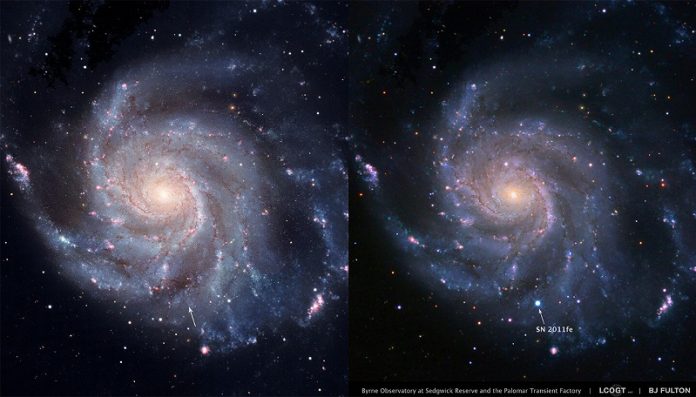
More than two decades ago, astronomers made a discovery that changed our view of the universe: it’s not just expanding, it’s expanding faster and faster.
That surprise came from studying about 50 exploding stars called Type Ia supernovae.
The unknown force causing this acceleration was named “dark energy”—and it earned a Nobel Prize in 2011.
Since then, scientists have been collecting more and more data, measuring over 2,000 Type Ia supernovae using different telescopes and methods.
These special supernovae all explode with a consistent brightness, making them useful as “standard candles” to measure distances across the universe.
However, mixing data from various experiments without accounting for their differences is like comparing apples to oranges. To solve this, an international team of scientists created the largest standardized set of supernova data ever assembled, called Union3.
Union3 includes data on 2,087 supernovae collected from 24 different projects.
By carefully adjusting for differences in observation methods and equipment, the team turned this massive collection into a powerful tool for understanding how dark energy behaves over time.
Their work was led by the Supernova Cosmology Project, based at the Department of Energy’s Lawrence Berkeley National Laboratory.
What they found is intriguing: this new supernova analysis hints that dark energy might not be constant after all—it may be changing over time.
The results aren’t strong enough yet to make a definitive claim, but they align with findings from another major project called the Dark Energy Spectroscopic Instrument (DESI), which uses a different method to study dark energy by examining how galaxies are clustered.
Saul Perlmutter, who won the Nobel Prize for the original dark energy discovery and is a co-author on the new paper, said scientists aren’t celebrating just yet, but they are paying close attention.
“Two different techniques are now showing signs that dark energy may not be constant, which could mean big changes for how we understand the universe,” he said.
Current models, like the Lambda Cold Dark Matter (or Lambda CDM) model, assume dark energy has always had the same strength.
In this model, “Lambda” stands for dark energy, and “CDM” refers to cold dark matter, which slows expansion. If dark energy is weakening over time, as the new data may suggest, the universe might not expand forever—it could slow down, stop, or even begin to contract.
To build Union3, scientists used a complex statistical method called a Bayesian Hierarchical Model.
This technique helps them manage uncertainties, such as how telescope filters may drift over time or how much light is lost during observations. The result is a much more accurate and flexible way to combine data from different telescopes and time periods.
Union3 builds on a previous dataset from 2010 called Union2, which included 557 supernovae. With the new method, researchers plan to add even more data soon, including hundreds of nearby supernovae where precision is especially important.
These additions could strengthen—or challenge—this early evidence of changing dark energy.
Greg Aldering, a physicist at Berkeley Lab and co-author of the paper, emphasized how crucial calibration is for this type of work. “We believe we now understand how to calibrate the data better than ever, and we’re excited to see what more supernovae will reveal,” he said.
Looking ahead, even bigger datasets are on the way. The Vera C. Rubin Observatory and NASA’s upcoming Nancy Grace Roman Space Telescope will observe hundreds of thousands of new supernovae in the next decade.
Combined with other methods like baryon acoustic oscillations (which measure the large-scale pattern of galaxies) and data from the cosmic microwave background, scientists hope to build a much clearer picture of how the universe is evolving.
As Perlmutter noted, “We’ve been waiting to reach this level of precision for a long time. Now that we’re here, we may finally start unlocking the true nature of dark energy.”



